| |
Norse God and Goddess Names
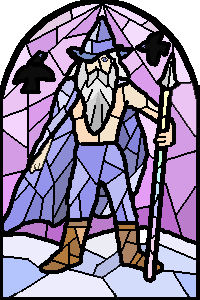
Odin
(or, depending upon the dialect Woden or Wotan) was the Father of all the
Gods and men. Odhinn is pictured either wearing a winged helm or a
floppy hat, and a blue-grey cloak. He can travel to any realm within
the 9 Nordic worlds. His two ravens, Huginn and Munin (Thought and
Memory) fly over the world daily and return to tell him everything that
has happened in Midgard. He is a God of magick, wisdom, wit, and
learning. He too is a psychopomp; a chooser of those slain in battle.
In later times, he was associated with war and bloodshed from the Viking
perspective, although in earlier times, no such association was present.
If anything, the wars fought by Odhinn exist strictly upon the Mental
plane of awareness; appropriate for that of such a mentally polarized God.
He is both the shaper of Wyrd and the bender of Orlog; again, a task only
possible through the power of Mental thought and impress. It is he
who sacrifices an eye at the well of Mimir to gain inner wisdom, and later
hangs himself upon the World Tree Yggdrasil to gain the knowledge and
power of the Runes. All of his actions are related to knowledge,
wisdom, and the dissemination of ideas and concepts to help Mankind.
Because there is duality in all logic and wisdom, he is seen as being
duplicitous; this is illusory and it is through his actions that the best
outcomes are conceived and derived. Just as a point of curiosity:
in no other pantheon is the head Deity also the God of Thought and Logic.
It's interesting to note that the Norse/Teutonic peoples also set such a
great importance upon brainwork and logic. The day Wednesday (Wodensdaeg)
is named for him.

Thor,
or Donnar, also known as the Thunderer, was considered to be a son of Odin
by some, but among many tribes Thor actually supplanted Odin as the
favorite god. He is considered to be the protector of all Midgard, and he
wields the mighty hammer Mjollnir. Thor is strength personified. His
battle chariot is drawn by two goats, and his hammer Mjollnir causes the
lightning that flashes across the sky. Of all the deities, Thor is the
most "barbarian" of the lot; rugged, powerful, and lives by his
own rules, although he is faithful to the rest of the Aesir. The day
Thursday (Thorsdaeg) is sacred to him.
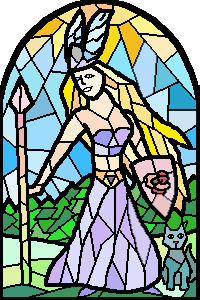
Freya
is considered to be the goddess of Love and Beauty, but is also a warrior
goddess and one of great wisdom and magick. She and her twin brother Freyr
are of a different "race" of gods known as the Vanir. Many of
the tribes venerated her higher than the Aesir, calling her "the
Frowe" or "The Lady." She is known as Queen of the
Valkyries, choosers of those slain in battle to bear them to Valhalla (the
Norse heaven). She, therefore, is a psychopomp like Odhinn and it is said
that she gets the "first pick" of the battle slain. She wears
the sacred necklace Brisingamen, which she paid for by spending the night
with the dwarves who wrought it from the bowels of the earth. The cat is
her sacred symbol. There seems to be some confusion between herself and
Fricka, Odin's wife, as they share similar functions; but Fricka seems to
be strictly of the Aesir, while Freya is of the Vanic race. The day Friday
(Frejyasdaeg) was named for her (some claim it was for Fricka).
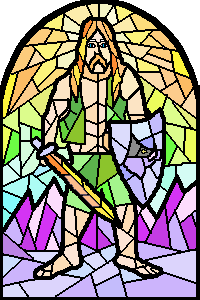
Freyr
(Fro Ingwe) is Freya's twin brother. He is the horned God of fertility,
and has some similarities to the Celtic Cernunnos or Herne, although he is
NOT the same being. He is known as King of the Alfs (elves). Both the
Swedish and the English are said to be descendents of his. The Boar is his
sacred symbol, which is both associated with war and with fertility. His
golden boar, "Gullenbursti", is supposed to represent the
daybreak. He is also considered to be the God of Success, and is
wedded to Gerda, the Jotun, for whom he had to yield up his mighty sword.
At Ragnarok, he is said to fight with the horn of an elk (much more suited
to his nature rather than a sword.)
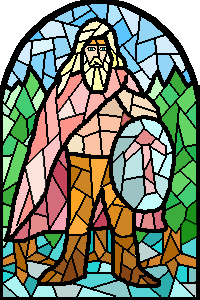
Tyr
(or Tiw, Ziw) is the ancient god of War and the Lawgiver of the gods. He
sacrifices his hand so that the evil Fenris wolf may be bound. At one time
he was the leader of the Norse Pantheon, but was supplanted by Odin much
later. There is nothing to indicate how this occurred; one assumes that he
simply "stepped back" and let Odin assume the position of
leadership. Tyr is excellent in all manners of Justice, fair play, and
Right Action.
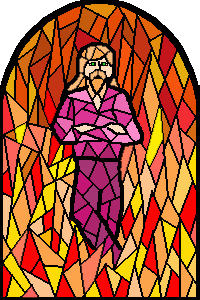
Loki,
the Trickster, challenges the structure and order of the Gods, but is
necessary in bringing about needed change. He is also known as the god of
Fire. Neither an Aesir or a Vanir, he is of the race of Ettins
(Elementals) and thus possesses some daemonic qualities. He is both a
helper and a foe of the Aesir; he gets them out of predicaments, but
spawns the worst monsters ever seen on the face of the Earth: the Fenris
Wolf and Jormurgandr, the Midgard Wyrm. His other children include the
goddess Hel (Hella, Holle), and Sleipnir, Odin's 8-legged horse; these
beings are at least benign, if not somewhat terrifying to behold.
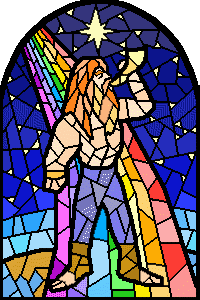
Heimdall
is the handsome gold-toothed guardian of Bifrost, the rainbow bridge
leading to Asgard, the home of the Gods. The rainbow bridge seems to be a
common symbol in many religious traditions other than Norse Heathenism. In
the Vedic tradition, it represents the Antakaranha of humanity (connection
between the body and the soul). Other traditions see it as a message from
the Gods, or a Bridge between the Gods and Mankind. This would tend to
indicate that the Norse/Germanic people were aware of the presence of an
overshadowing Soul for each individual, as well as a group or tribal
intelligence. It is Heimdall who is to sound the signal horn to the Aesir
that Ragnarok, the great destruction (or transformation?) is beginning.
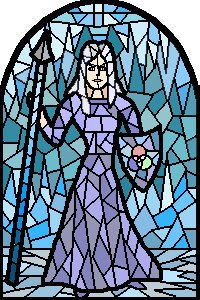
Skadi
is the Goddess of Winter and of the Hunt. She is married to Njord, the
gloomy Sea God, noted for his beautiful bare feet (which is how Skadi came
to choose him for her mate.) Supposedly the bare foot is an ancient Norse
symbol of fertility. The marriage wasn't too happy, though, because she
really wanted Baldur for her husband. She is the goddess of Justice,
Vengeance, and Righteous Anger, and is the deity who delivers the sentence
upon Loki to be bound underground with a serpent dripping poison upon his
face in payment for his crimes. Skadi's character is represented in
two of Hans Christian Anderson's tales: "The Snow Queen"
and "The Ice Princess."
Frigga (Frigg, Fricka), Odin's wife, was considered
to be the Mother of all; and protectoress of children. She spins the
sacred Distaff of life, and is said to know the future, although she will
not speak of it. Some believe that Friday was named for her instead of
Freya (see above), and there is considerable confusion as to "who
does what" among the two.
The Norns (Urd, Verdande, and Skuld), are the Norse
equivalent of the greek Fates. It is they who determine the orlogs
(destinies) of the Gods and of Man, and who maintain the World Tree,
Yggdrasil.
The goddess of the dead and the afterlife was Hel (Holle,
Hulda), and was portrayed by the Vikings as being half-dead, half alive
herself. The Vikings viewed her with considerable trepidation. The Dutch,
Gallic, and German barbarians viewed her with some beneficence, more of a
gentler form of death and transformation. She is seen by them as Mother
Holle; a being of pure Nature, being helpful in times of need, but
vengeful upon those who cross her or transgress natural law.
Odin's son, Baldur, the god of Love and Light, is
sacrificed at Midsummer by the dart of the mistletoe, and is reborn at Jul
(Yule). Supposedly his return will not occur until after the onslaught of
the Ragnarok, which I see as a cleansing and enlightenment more than
wanton, purposeless destruction. Baldur's blind brother Hodur was his
slayer, whose hand was guided by the crafty Loki. He is married to the
goddess of Joy, Nanna.
Other Gods and Goddesses include Sif (Sifa), the
Harvest Goddess; Forseti, the god of Law and Justice; Bragi, the bard of
the Gods and muse of Poetry; Weiland (Weyland), the Smith of the Gods,
Idunna, the goddess of Youth and Beauty; Vidar and Vali, the sons of Odin
who will survive Ragnarok; Magni and Modi, the sons of Thor; Eostre, the
goddess of Spring and of fertility, Hoenir, the messenger of the Aesir;
Sunna and Mani, the Sun and Moon; Ullr, the God of the Hunt; and Nerthus,
Goddess of the Sea and of Rivers.
Astrological Connections
Purists of the Norse Religion may scoff
at the idea of associating the various Gods and Goddesses to a system that
was not originated by the Norse. However, for comparison purposes,
it is helpful to be able to associate the deities with the various signs
of the zodiac; if for no other reason than to help in astrological chart
interpretations using a Norse background.
Aries: the fiery Loki, and Ostara,
the goddess of Spring
Taurus: both the youthful Idunna
and Weiland, smith of the Gods.
Gemini: Both Freyr and Freyja as
the Twins.
Cancer: Blissful mother Fricka (Frigg);
also Manni; Lord of the Moon
Leo: Mighty Thor; also, Sunna (the
Sun)
Virgo: Sif (Sifa), the wife of
Thor and Frowe of the harvest
Libra: Tyr, the lawgiver of the
Gods; also Forseti, the god of Justice
Scorpio: Hela (Holle); Goddess of
Death and Rebirth
Sagittarius: Allfather Odin
(mounted on Sleipnir)
Capricorn: Skadi; Goddess of
Winter and the Hunt; also Ullr, Lord of the Hunt
Aquarius: Heimdall, Guardian of
the Rainbow Bridge
Pisces: Both Njord and Nerthus;
God and Goddess of the Oceans and Rivers.
| |

